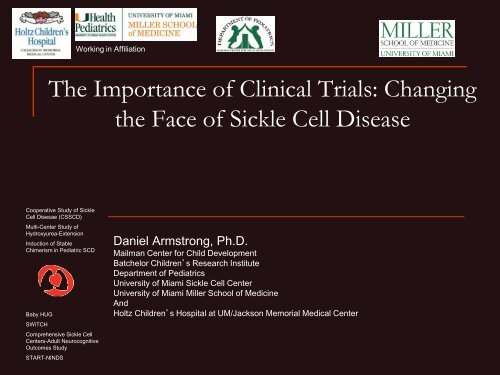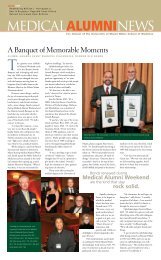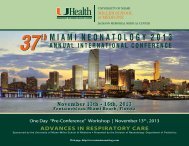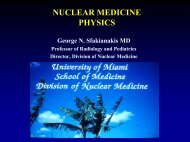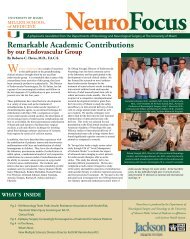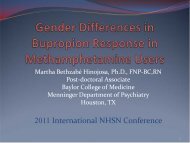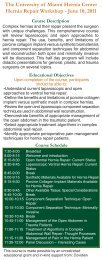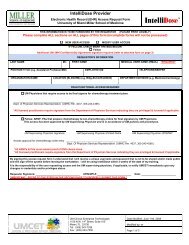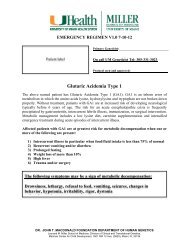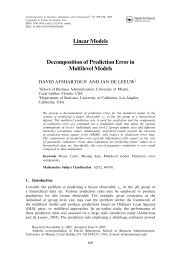download pdf - Department of Pediatrics - University of Miami
download pdf - Department of Pediatrics - University of Miami
download pdf - Department of Pediatrics - University of Miami
Create successful ePaper yourself
Turn your PDF publications into a flip-book with our unique Google optimized e-Paper software.
Working in Affiliation<br />
The Importance <strong>of</strong> Clinical Trials: Changing<br />
the Face <strong>of</strong> Sickle Cell Disease<br />
Cooperative Study <strong>of</strong> Sickle<br />
Cell Disesae (CSSCD)<br />
Multi-Center Study <strong>of</strong><br />
Hydroxyurea-Extension<br />
Induction <strong>of</strong> Stable<br />
Chimerism in Pediatric SCD<br />
Baby HUG<br />
SWiTCH<br />
Comprehensive Sickle Cell<br />
Centers-Adult Neurocognitive<br />
Outcomes Study<br />
START-NINDS<br />
Daniel Armstrong, Ph.D.<br />
Mailman Center for Child Development<br />
Batchelor Children’s Research Institute<br />
<strong>Department</strong> <strong>of</strong> <strong>Pediatrics</strong><br />
<strong>University</strong> <strong>of</strong> <strong>Miami</strong> Sickle Cell Center<br />
<strong>University</strong> <strong>of</strong> <strong>Miami</strong> Miller School <strong>of</strong> Medicine<br />
And<br />
Holtz Children’s Hospital at UM/Jackson Memorial Medical Center
Sickle Cell Disease: Background<br />
• Hemoglobinopathy<br />
(HbS) affecting 1 in 800<br />
Black babies born in the<br />
United States<br />
• Newborn screening<br />
detects approximately<br />
2000 new cases each<br />
year<br />
• Most common variants<br />
are HbSS, HbSβ-thal,<br />
HbSβ0, and HbSC<br />
• Carriers (HbS-trait-FAS,<br />
FAC, FAE) are<br />
assumed asymptomatic;<br />
ratio <strong>of</strong> trait to SCD is<br />
50:1<br />
2
Sickle Cell Pathophysiology<br />
• Vaso-occlusion can occur in any organ in the<br />
body<br />
• Commonly affected organs include:<br />
<br />
<br />
<br />
<br />
<br />
<br />
<br />
Spleen<br />
Brain<br />
Bone Marrow<br />
Retina<br />
Lungs<br />
Kidney<br />
Skin<br />
CTC Neuropsych Phase II Central Training, May 2009<br />
3
The Story <strong>of</strong> Sickle Cell Disease<br />
• 1910: Dr. James Herrick and his intern,<br />
Ernest Irons, described and linked clinical<br />
symptoms to abnormal hemoglobin, termed<br />
sickle cell anemia (in 1922)<br />
• First patient: Walter Clement Noel, a 20 year<br />
old dental student from Granada studying at<br />
the <strong>University</strong> <strong>of</strong> Chicago
Sickle Cell Disease: Basic Research<br />
• Understanding <strong>of</strong> the genetics <strong>of</strong><br />
sickle cell disease advanced<br />
from 1910 until the early 1980s,<br />
but no significant clinical<br />
advances<br />
1927: Hahn &<br />
Gillespie<br />
associate<br />
sickling with<br />
low oxygen<br />
concentration<br />
1956: Ingram &<br />
Hunt sequence<br />
hemoglobin and<br />
discover that<br />
the change <strong>of</strong> a<br />
single amino<br />
acid in protein<br />
sequence is<br />
cause <strong>of</strong> SCA<br />
1910: Herrick<br />
provides<br />
description <strong>of</strong><br />
sickle cells in<br />
symptomatic<br />
patient<br />
1949: Linus Pauling<br />
publish: Sickle Cell<br />
Anemia: A Molecular<br />
Disease in Science.<br />
Cause <strong>of</strong> disease<br />
associated with change<br />
in protein structure<br />
1978: Flavel<br />
prepares maps<br />
<strong>of</strong> the human<br />
beta and delta<br />
globin genes
Sickle Cell Research: A Brief History<br />
The Comprehensive Sickle Cell Centers<br />
• 1972: NIH/NHLBI established the<br />
Comprehensive Sickle Cell Centers (CSCC)<br />
<br />
<br />
<br />
Presidential Initiative & Congressional mandate<br />
NHLBI Sickle Cell Disease Advisory Committee<br />
mandated<br />
Emphasis on<br />
• Basic research<br />
• Clinical care and research<br />
• Patient and Community Outreach
Finally: Clinical Studies with Patients<br />
• 1982: Clinical Advances Start to Emerge<br />
1982: Clinical<br />
observation <strong>of</strong> increase<br />
mortality due to<br />
overwhelming sepsis in<br />
children under 4 led to<br />
PROPS study<br />
(prophylactic penicillin).<br />
Study stopped early and<br />
prophylactic penicillin<br />
became the standard <strong>of</strong><br />
care.<br />
MSH<br />
1995: Multicenter Study<br />
<strong>of</strong> Hydroxyurea stopped<br />
early because <strong>of</strong> clear<br />
benefits <strong>of</strong> HU for pain in<br />
adults with SCA<br />
2010: Chronic<br />
anemia linked to<br />
neurocognitive<br />
impairment in<br />
adults with SCD;<br />
transfusion trial<br />
started<br />
1984: Accidental cure<br />
discovered as child<br />
with SCA treated for<br />
leukemia with bone<br />
marrow transplant is<br />
cured <strong>of</strong> SCA<br />
1996: CSSCD and STOP trials show<br />
17% incidence <strong>of</strong> silent cerebral infarct<br />
and association between elevated<br />
cerebral vascular flow rate and stroke in<br />
children; chronic transfusion trial<br />
stopped early, became standard <strong>of</strong> care<br />
2011: BABY HUG Trial<br />
Completed- hydroxyurea<br />
safe and demonstrates<br />
clinical significance for pain<br />
and other clinical symptoms<br />
in infants and toddlers
Sickle Cell Research: A Brief History<br />
Outside the Centers<br />
• Comprehensive Study <strong>of</strong> Sickle Cell Disease<br />
(CSSCD)<br />
1978-1998<br />
<br />
<br />
<br />
<br />
709 infants enrolled in natural history study<br />
1988: Brain Study started<br />
1994: Kidney, Psychosocial, MRA emphasized<br />
CSSCD fundamentally changed understanding <strong>of</strong> critical clinical<br />
issues in SCD<br />
• Stroke and stroke onset<br />
• Mortality<br />
• Disease Severity<br />
• Pulmonary Issues
Cognitive Functioning in Children with Sickle Cell Disease<br />
Cooperative Study <strong>of</strong> Sickle Cell Disease<br />
100<br />
90<br />
80<br />
70<br />
60<br />
50<br />
40<br />
30<br />
20<br />
10<br />
0<br />
FSIQ VIQ PIQ MATH READING<br />
Normal MRI<br />
Silent MRI<br />
Clinical+ MRI<br />
Armstrong, Thompson, et al., <strong>Pediatrics</strong>, 97, 1996
Sickle Cell Research: A Brief History<br />
Outside the Centers<br />
• 1983: PROPS, PROPS II<br />
<br />
<br />
<br />
NHLBI funded multi-center study <strong>of</strong> prophylactic<br />
penicillin<br />
Stopped early because <strong>of</strong> definitive outcomes<br />
Established prophylaxis as standard <strong>of</strong> care<br />
and led to SCD specific guidelines for later<br />
immunizations
Sickle Cell Research: A Brief History<br />
Outside the Centers<br />
• Stroke Prevention Trial in Sickle Cell Anemia<br />
(STOP)<br />
<br />
<br />
<br />
<br />
Multicenter study <strong>of</strong> Transcranial Doppler<br />
Ultrasonography (TCD) <strong>of</strong> cerebral arteries to predict<br />
stroke risk<br />
Children with vascular flow rates >200cm/sec<br />
randomized to chronic transfusion/no transfusion<br />
Study stopped early because transfusion<br />
prevented subsequent stroke; Established TCD<br />
screening as standard <strong>of</strong> care.<br />
STOP II: Found transfusion must be continued
Hydroxyurea<br />
• Initially used in treatment <strong>of</strong> chronic leukemia<br />
• Can lower WBC, needs to be monitored<br />
• Mechanism: Hydroxyurea stimulates the<br />
production <strong>of</strong> Hemoglobin F (HbF), therefore<br />
reducing the concentration <strong>of</strong> HbS and the<br />
likelihood <strong>of</strong> sickling
Sickle Cell Research: A Brief History<br />
Outside the Centers<br />
• Multi-center Study <strong>of</strong> Hydroxyurea (MSH)<br />
Opened in 1997<br />
<br />
<br />
<br />
Adults with HbSS, ages 18-50 with at least 3 ED or<br />
hospitalizations for pain<br />
Mechanism in SCD is increase in fetal hemoglobin<br />
(HbF) production that reduces HbS concentration<br />
and propensity to sickling<br />
Study stopped prematurely because <strong>of</strong><br />
significant results, established standard <strong>of</strong> care<br />
for prevention <strong>of</strong> pain in adolescents & adults
Sickle Cell Research: A Brief History<br />
Outside the Centers<br />
• Hydroxyurea Safety and Organ Toxicity<br />
[HUSOFT] trial<br />
<br />
<br />
<br />
<br />
21 infants in multi-center trial using liquid<br />
hydroxyurea<br />
Follow-up from 4 to 6 years<br />
Infants with SCA tolerate prolonged hydroxyurea<br />
therapy with sustained hematologic benefits,<br />
fewer ACS events, improved growth, and possibly<br />
preserved organ function.<br />
Established safety data for initiation <strong>of</strong> Baby HUG.
Sickle Cell Research: Ongoing Studies<br />
• 2001: Baby HUG<br />
<br />
<br />
<br />
<br />
Multi-center study <strong>of</strong> 200 infants<br />
(9-18 mos old at enrollment)<br />
randomized to hydroxyurea or<br />
placebo<br />
Primary outcomes: liver and<br />
splenic function<br />
Secondary: Neurodevelopment<br />
Results 2011: HU safe, had<br />
significant clinical benefits (Wang et<br />
al, The Lancet, 2011)
Sickle Cell Research: Ongoing Studies<br />
• Stroke With Transfusions Changing to<br />
Hydroxyurea (SWiTCH)<br />
<br />
<br />
<br />
Multi-center, randomized cross-over clinical trial<br />
130 children 6-18 years with infarct treated with<br />
transfusion for at least 18 months<br />
Outcomes<br />
• Secondary stroke<br />
• Management <strong>of</strong> iron overload<br />
• Neurodevelopment<br />
• Quality <strong>of</strong> life
Sickle Cell Research: Ongoing Studies<br />
• Silent Infarction Transfusion Trial (SITT)<br />
<br />
Multi-center, international study <strong>of</strong> chronic<br />
transfusion and prevention <strong>of</strong> silent infarct<br />
• Neuropsychologic Function and Imaging in<br />
Adults with Sickle Cell Disease: A Pilot<br />
Transfusion Study<br />
Multi-center study <strong>of</strong> 140 adults with HbSS (25-40<br />
years old) with no history <strong>of</strong> neurologic disease<br />
who have hemoglobin < 9 gms<br />
• Significant differences with community controls on IQ<br />
• Cognitive function significantly associated with anemia
Hematopoietic Stem Cell Transplantation in<br />
Sickle Cell Disease<br />
• Bone Marrow Transplant Clinical Research<br />
Network (BMT-CRN) established 2001<br />
<br />
<br />
<br />
<br />
HSCT is the only known cure for SCD<br />
Full and mixed chimerism approaches underway<br />
10% procedure-related mortality<br />
Limited to patients with significant clinical<br />
conditions (e.g., stroke, repeated ACS)<br />
• Sickle Cell Unrelated Transplant (SCURT)<br />
<br />
Multi-center trial using unrelated donors to begin<br />
in 2009
Translation <strong>of</strong> Research to Clinical<br />
Practice: A Summary <strong>of</strong> Highlights<br />
• Prevention <strong>of</strong> overwhelming bacterial sepsis<br />
through prophylaxis and immunization<br />
(PROPS)<br />
• TCD Screening <strong>of</strong> Infants and Toddlers<br />
(STOP)<br />
• Hydroxyurea for prevention <strong>of</strong> pain and other<br />
symptoms (MSH, HUSOFT)<br />
• Oral chelators used to prevent iron overload
Sickle Cell Disease: Policy from Science<br />
• Newborn screening legislation enacted in all<br />
50 states, new standards <strong>of</strong> care<br />
<br />
<br />
<br />
Prophylactic penicillin<br />
Transcranial Dopper ultrasonography<br />
Vaccinations for H-flu standard
Sickle Cell Disease: Policy from Science<br />
• Quality-<strong>of</strong>-Care Indicators for<br />
Children With Sickle Cell<br />
Disease (Wang et al, 2011,<br />
<strong>Pediatrics</strong>)<br />
<br />
Expert panel produces evidencebased<br />
quality <strong>of</strong> care indicators<br />
for treatment <strong>of</strong> children with<br />
sickle cell disease world wide<br />
DOI: 10.1542/peds.2010-1791<br />
<strong>Pediatrics</strong>; originally published<br />
online August 15, 2011;<br />
Philippa G. Sprinz<br />
C. Jason Wang, Patricia L.<br />
Kavanagh, Alison A. Little, Jaime<br />
Bruce Holliman and Phillipa G.<br />
Sprinz<br />
<strong>Pediatrics</strong>; originally published<br />
online August 15, 2011;
With All This Research, Where Are<br />
We?<br />
• Management <strong>of</strong> acute pain has not changed<br />
substantially in more than a half century<br />
• Low incidence problems (e.g., leg ulcers, kidney<br />
disease, retinal disease) have seen no<br />
significant advances<br />
• Although more than 50% <strong>of</strong> children with SCA<br />
have neurocognitive deficits related to vascular,<br />
hypoxic, anemic, or pulmonary challenges, very<br />
few are identified for special services in the<br />
schools
Why the Disconnect?<br />
• While all 50 states have mandatory newborn<br />
screening for SCD, only a few have effective<br />
follow-up programs<br />
• The Comprehensive Sickle Cell Centers<br />
provided outstanding service, but there were<br />
only 10 and they have not been<br />
geographically located near SCD population<br />
centers<br />
• The Clinical Research Network only added 4<br />
new centers to the CSCC network
Addressing the Clinical and Translational<br />
Research Needs in SCD is not Easy!<br />
• Pediatric and adult emphases are different<br />
<br />
<br />
Prevention vs. acute and chronic care focus<br />
Underlying clinical infrastructure differs for<br />
children and adults<br />
• Adults over 21 <strong>of</strong>ten cannot be admitted to children’s<br />
hospitals<br />
• Severe and growing shortage <strong>of</strong> medicine hematologists<br />
• Clinical revenue doesn’t sustain the clinical<br />
enterprise
Addressing the Clinical and Translational<br />
Research Needs in SCD is not Easy!<br />
• Today, basic science supporting clinical and<br />
translational research in SCD is minimal<br />
<br />
<br />
NIH budget for SCD-related basic research is<br />
substantially smaller than for other low incidence<br />
diseases<br />
Pharmaceutical industry development <strong>of</strong> new<br />
orphan drugs has not been a priority, but that is<br />
changing
Addressing the Clinical and Translational<br />
Research Needs in SCD is not Easy!<br />
• Numerous scientific clinical research<br />
challenges<br />
<br />
<br />
<br />
Multiple organ involvement requires<br />
participation by many specialties that have<br />
not historically worked together<br />
Clinical focus shifts across the lifespan<br />
Meaningful endpoints <strong>of</strong> some clinical trials<br />
may take decades to determine
Addressing Clinical and Translational<br />
Research Needs in SCD is not Easy!<br />
• Participant Concerns<br />
<br />
<br />
<br />
Geographic access to a clinical research center<br />
Time, distance, travel expenses<br />
Participant burden<br />
• Number <strong>of</strong> studies<br />
• Lifetime research participant?<br />
Relevance <strong>of</strong> research to participant concerns
Other Critical Collaborations<br />
Community Based Organizations<br />
Can play principal role as advocate for sickle<br />
cell<br />
Research funding<br />
Clinical care funding<br />
Can legally advocate for sickle cell support at<br />
local, state, and federal level without<br />
compromising <strong>University</strong> legislative agendas<br />
Can be major partner in participant recruitment<br />
for clinical trials and community support
Florida’s Challenges<br />
• One <strong>of</strong> largest populations <strong>of</strong> children and<br />
adults with SCD in the United States<br />
• CMS does excellent job with follow-up near<br />
pediatric centers, but some inevitably still<br />
don’t receive follow-up and standard <strong>of</strong> care<br />
• Pediatric centers see more than 4000<br />
children with SCD<br />
• Adult care infrastructure is minimal<br />
• Florida SCD mortality rate has historically<br />
been greater than national average
Florida’s Opportunities<br />
• Florida pediatric centers have history <strong>of</strong><br />
collaboration (e.g, FAPTP)<br />
• Florida has the opportunity to be the “St.<br />
Jude or Dana Farber” <strong>of</strong> sickle cell disease<br />
<br />
<br />
Lead consortium for Phase I and Phase II trials<br />
and innovation<br />
Anchor for national clinical trials network<br />
• Florida can improve implementation <strong>of</strong> clinical<br />
standards <strong>of</strong> care-Center <strong>of</strong> Excellence
What Do We Need to Do?<br />
• Make clinical trials available<br />
• Education the sickle cell community about the<br />
role clinical trials can play in improving how<br />
we treat and ultimately cure sickle cell<br />
disease<br />
• Make it possible for those interested to<br />
participate<br />
• Inform the community about what we learn
Final Consideration<br />
• Clinical trials in childhood cancer have<br />
changed survival from 40% to more than<br />
80%. Why can’t we do have the same<br />
impact for Sickle Cell Disease?
Contributors and Colleagues<br />
• <strong>University</strong> <strong>of</strong> <strong>Miami</strong> Sickle Cell Center<br />
<br />
Charles H. Pegelow, M.D. (deceased),<br />
Astrid Mack, Ph.D., Ofelia Alvarez,<br />
M.D., Tom Harrington, M.D., Don<br />
Temple, M.D., Maria Goldman, Psy.D.,<br />
Stuart Toledano, M.D., Julio Barredo,<br />
M.D., Wisvline LaBrousse, Ph.D., Tally<br />
Hustace, Elizabeth Willen, Ph.D., Rita<br />
Bhatia, M.D. Ellen White, ARNP,<br />
Noeline Lewis, ARNP, Winsome<br />
Thompson, Ph.D., Armande Gil, Ph.D.<br />
• Cooperative Study <strong>of</strong> Sickle Cell<br />
Disease (CSSCD)<br />
<br />
Robert Thompson, Jr., Ph.D., Marilyn<br />
Gaston, M.D., Tom Kinney, M.D.,<br />
Clarise Reid, M.D., Dianne Gallagher,<br />
Ph.D., Carol Link, Ph.D., Don<br />
Brambilla, Ph.D.<br />
• Baby HUG<br />
<br />
Win Wang, Ph.D., Scott Miller, M.D.,<br />
Rene Rees, David Elkin, Ph.D., Penny<br />
Glass, Ph.D., Clark Brown, M.D.<br />
• NHLBI Sickle Cell Disease Advisory<br />
Committee<br />
• Comprehensive Sickle Cell Centers<br />
Phase I & II Clinical Trials Consortium<br />
<br />
Elliott Vichinsky, M.D., Jeffrey Gold,<br />
Ph.D., Mike Wiener, M.D., Randall<br />
Rule, M.D., Allison Muma, Jamie<br />
Spencer, Cathie Snyder, Susan Lief,<br />
Ph.D., Karen Kesler, Ph.D., Barry<br />
Eggleston, Ph.D.; Lynne Neumayr,<br />
M.D., Clinton Joyner, M.D.<br />
• BMT & Mixed Chimerism<br />
<br />
Mark Walters, M.D.<br />
• Multi-Center Study <strong>of</strong> Hydroxyurea<br />
(MSH)<br />
<br />
• SWiTCH<br />
<br />
Martin Steinberg, M.D., Wally Smith,<br />
M.D., Bruce Barton, M.D., Adrienne<br />
Brandon<br />
Russell Ware, M.D., Melanie Bonner,<br />
Ph.D.<br />
• NINDS Start Trial<br />
• James Eckman, M.D., Ronald Brown,<br />
Ph.D.<br />
• Many post-doctoral fellows and<br />
graduate students


